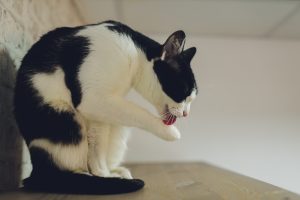
Hairballs are a common occurrence. There are several things you can do to prevent them.
Hairballs in Cats: What You Need to Know
Hairballs are a common problem for many cats. If you have a cat, you might have seen them cough up a hairball before. But what exactly are hairballs, and why do cats get them?
Cats are very clean animals and love to groom themselves. When they lick their fur, their tongue picks up loose hair [1]. Most of this hair goes through their digestive system and comes out in their poop. However, sometimes the hair stays in their stomach and forms a ball [2]. This is what we call a hairball.
Hairballs are more common in cats with long hair, like Persians or Maine Coons [3]. Cats that groom themselves a lot, maybe because they are stressed or have itchy skin, can also get hairballs more often [4].
So, how do you know if your cat has a hairball? Some signs to look out for are [5]:
1. Coughing or gagging noises
2. Throwing up, especially if there’s a clump of hair in it
3. Not wanting to eat
4. Being less active than usual
5. Having trouble pooping or having diarrhea
If your cat has these symptoms a lot, it’s best to take them to the vet to make sure there’s nothing else wrong.
How to Help Prevent Hairballs
To help stop hairballs from forming, there are a few things you can do. One of the best ways is to brush your cat’s fur regularly [6]. This helps get rid of loose hair before your cat can swallow it. It’s especially important for cats with long hair.
You can also try giving your cat food that is made to help with hairballs. These foods have more fiber, which helps the hair move through their digestive system more easily [7]. Some people also give their cats a little bit of Vaseline or butter to help the hair slide through their system [8].Check with your veterinarian before giving your any home remedies.
Remember, while it’s normal for cats to have hairballs sometimes, having them too often can be a sign of other health problems [9]. If you’re worried about your cat’s hairballs, always talk to your vet. They can help you figure out the best way to keep your cat healthy and happy.
In short, hairballs are a normal part of being a cat, but there are things you can do to help prevent them. Regular brushing, special food, and occasional hairball remedies can all make a difference. And if you’re ever unsure, your vet is always there to help.
You can read our previous article on hairball prevention here.
Citations:
[1] Cornell Feline Health Center. (2021). Hairballs.
[2] American Society for the Prevention of Cruelty to Animals. (n.d.). Hairballs.
[3] Shojai, A. (2021). Hairballs in Cats: Causes, Symptoms, and Treatment. The Spruce Pets.
[4] Flowers, A. (2019). Excessive Grooming in Cats. PetMD.
[5] Llera, R., & Downing, R. (2020). Hairballs in Cats. VCA Hospitals.
[6] Wooten, S. (2019). How to Prevent Hairballs in Cats. Chewy.
[7] Syufy, F. (2021). The Best Cat Food for Hairball Control. The Spruce Pets.
[8] Garvey, M. (2016). Hairball Prevention and Remedy Options. PetMD.
[9] Norsworthy, G. (2018). Understanding Feline Hairballs. Veterinary Practice News.
